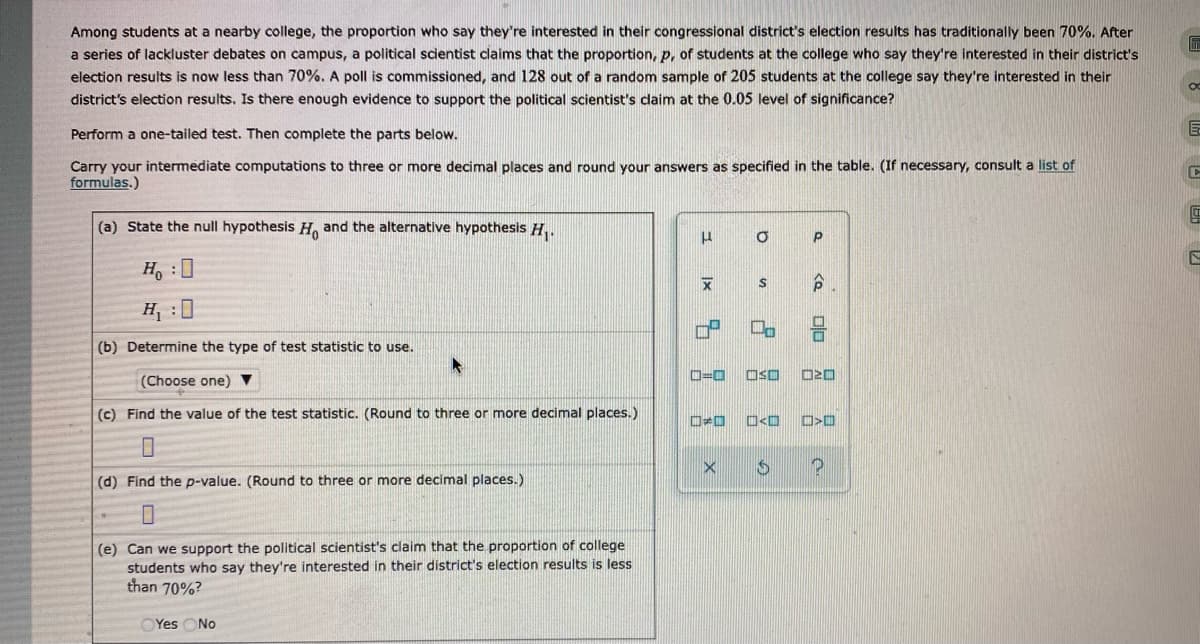Among students at a nearby college, the proportion who say they're interested in their congressional district's election results has traditionally been 70%. After a series of lackluster debates on campus, a political scientist daims that the proportion, p, of students at the college who say they're interested in their district's election results is now less than 70%. A poll is commissioned, and 128 out of a random sample of 205 students at the college say they're interested in their district's election results. Is there enough evidence to support the political scientist's claim at the 0.05 level of significance? Perform a one-tailed test. Then complete the parts below. Carry your intermediate computations to three or more decimal places and round your answers as specified in the table. (If necessary, consult a list of formulas.) (a) State the null hypothesis H and the alternative hypothesis H,. P H, :0 H :0 (b) Determine the type of test statistic to use. OSO (Choose one) ▼ (c) Find the value of the test statistic. (Round to three or more decimal places.) (d) Find the p-value. (Round to three or more decimal places.) (e) Can we support the political scientist's claim that the proportion of college students who say they're interested in their district's election results is less than 70%? Yes No
Among students at a nearby college, the proportion who say they're interested in their congressional district's election results has traditionally been 70%. After a series of lackluster debates on campus, a political scientist daims that the proportion, p, of students at the college who say they're interested in their district's election results is now less than 70%. A poll is commissioned, and 128 out of a random sample of 205 students at the college say they're interested in their district's election results. Is there enough evidence to support the political scientist's claim at the 0.05 level of significance? Perform a one-tailed test. Then complete the parts below. Carry your intermediate computations to three or more decimal places and round your answers as specified in the table. (If necessary, consult a list of formulas.) (a) State the null hypothesis H and the alternative hypothesis H,. P H, :0 H :0 (b) Determine the type of test statistic to use. OSO (Choose one) ▼ (c) Find the value of the test statistic. (Round to three or more decimal places.) (d) Find the p-value. (Round to three or more decimal places.) (e) Can we support the political scientist's claim that the proportion of college students who say they're interested in their district's election results is less than 70%? Yes No
Holt Mcdougal Larson Pre-algebra: Student Edition 2012
1st Edition
ISBN:9780547587776
Author:HOLT MCDOUGAL
Publisher:HOLT MCDOUGAL
Chapter11: Data Analysis And Probability
Section: Chapter Questions
Problem 8CR
Related questions
Question

Transcribed Image Text:Among students at a nearby college, the proportion who say they're interested in their congressional district's election results has traditionally been 70%. After
a series of lackluster debates on campus, a political scientist claims that the proportion, p, of students at the college who say they're interested in their district's
election results is now less than 70%. A poll is commissioned, and 128 out of a random sample of 205 students at the college say they're interested in their
district's election results. Is there enough evidence to support the political scientist's daim at the 0.05 level of significance?
Perform a one-tailed test. Then complete the parts below.
Carry your intermediate computations to three or more decimal places and round your answers as specified in the table. (If necessary, consult a list of
formulas.)
(a) State the null hypothesis H, and the alternative hypothesis H..
Ho :0
合
H :0
(b) Determine the type of test statistic to use.
(Choose one) ▼
D=0
OSO
(c) Find the value of the test statistic. (Round to three or more decimal places.)
D>O
(d) Find the p-value. (Round to three or more decimal places.)
(e) Can we support the political scientist's claim that the proportion of college
students who say they're interested in their district's election results is less
than 70%?
OYes ONo
Expert Solution
This question has been solved!
Explore an expertly crafted, step-by-step solution for a thorough understanding of key concepts.
This is a popular solution!
Trending now
This is a popular solution!
Step by step
Solved in 3 steps

Knowledge Booster
Learn more about
Need a deep-dive on the concept behind this application? Look no further. Learn more about this topic, statistics and related others by exploring similar questions and additional content below.Recommended textbooks for you

Holt Mcdougal Larson Pre-algebra: Student Edition…
Algebra
ISBN:
9780547587776
Author:
HOLT MCDOUGAL
Publisher:
HOLT MCDOUGAL

Holt Mcdougal Larson Pre-algebra: Student Edition…
Algebra
ISBN:
9780547587776
Author:
HOLT MCDOUGAL
Publisher:
HOLT MCDOUGAL